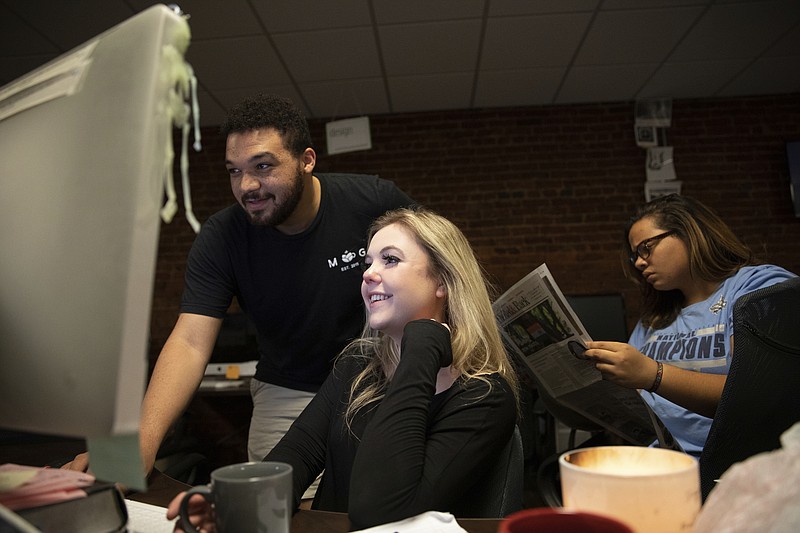SYRACUSE, N.Y. (AP) - The Daily Orange isn't daily anymore.
The student-run newspaper that has covered Syracuse University since 1903 and trained generations of journalists now prints three issues per week. Editor-in-chief Haley Robertson wonders where she'll find advertisers, worries about firing friends, and searches for alumni donors who will pay to send reporters on the road to cover the university's sports teams.
These are problems not unlike those that bedevil executives two or three times her age - evidence of how the news industry's woes have seeped onto campuses that try to harness youthful energy and idealism to turn out professionals who can inform the world.
Meanwhile, college journalism educators are changing the way they teach in a race against obsolescence. They're emphasizing versatility and encouraging a spirit of entrepreneurship.
After some brutal years, there are signs of life. Much as the journalistic pursuit of a crooked president in the 1970s inspired a generation, another leader who denounces reporters as enemies has given birth to a new resolve: Enrollment in journalism programs is up.
"When I look at local news and see what's happening, I'm pessimistic," said Kathleen Culver, journalism professor at the University of Wisconsin at Madison. "When I look at 18- and 20-year-olds and see what they want to do, I'm optimistic."
Thousands of young journalists train for the future on a dual track, in classrooms and in student-run newsrooms that are models for the places they hope to work someday.
The D.O. made national news in 2018 by posting video of racist and sexist comments made at a university fraternity, leading to its suspension. Catherine Leffert, Robertson's managing editor, covered the story.
"Seeing the layoffs and seeing newsroom cutbacks is really disheartening," Leffert said. "But what keeps me wanting to be a journalist and wanting to do it here is seeing the effect that the D.O. has. It's really cool and exciting."
Few college publications have shut down the way local newspapers in towns and cities across the country have, said Chris Evans, president of the College Media Association and adviser to the University of Vermont newspaper. Many are supported by student fees and pay their staff members little if anything.
Thirty-five percent of school papers said they have reduced the frequency of print issues to save money, according to a CMA survey taken earlier this year, and 5 percent are online only. Half the newspapers that haven't abandoned paper are printing fewer copies.
The University of North Carolina's Daily Tar Heel switched to three days a week in 2017 when its directors suddenly realized they were going broke, said Maddy Arrowood, the paper's editor-in-chief. The newspaper cut staff members' pay and moved into a smaller office.
The Daily Tar Heel is testing newsletters targeted at people with special interests, and its reporters go off campus to cover the surrounding community of Chapel Hill, North Carolina.
"I spend most of my time very aware of our financial situation," Arrowood said.
Struggling with a $280,000 debt, the Hilltop at Howard University printed its first edition this semester in mid-October. The Maneater at the University of Missouri used to print twice a week, then once. Now it's down to once a month.
Staff members are now charged annual dues - in other words, they must pay to work there, said Leah Glasser, the paper's editor. They can avoid the dues if they find an alumni sponsor or sell enough advertising to cover it.
"It's so difficult to hear, 'we don't have enough money,'" she said. "We hear that a lot. As a generation, that doesn't make us turn around and go home."
While some newspapers like the Daily Orange or Daily Tar Heel don't take money from the university or fellow students, most do. Tammy Merrett, faculty adviser to the Alestle at Southern Illinois University at Edwardsville, doesn't know how her paper would survive without it.
Despite the worries, North Carolina's Arrowood said her experience makes her more interested in a journalism career, not less.
"What I want to do is still something that people need," she said.
If they're being honest, most journalism educators have at some point wondered to themselves: Am I preparing young people for a dying industry? Even if I try to retool for a modern age, who will be interested in my school?
Newspaper newsroom jobs across the country sank from 52,000 in 2008 to 24,000 now, according to the University of North Carolina. There's more to journalism than newspapers, of course, but other media jobs can't make up for that kind of contraction.
"It's one thing to go into debt if you're an engineer or a graphic artist, because you know the jobs are going to be there," said Joel Kaplan, whose master's program in journalist at Syracuse routinely welcomed 48 new students each year at the turn of the century but dipped into the teens.
Schools with broader communications programs started emphasizing advertising and public relations majors. In journalism, universities are plugging more specialized programs like sports and watchdog reporting, and data journalism.

